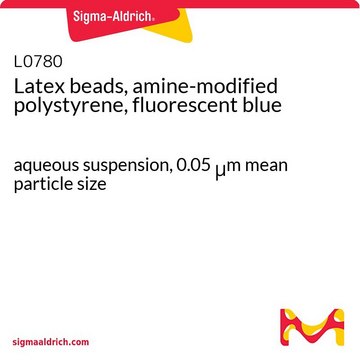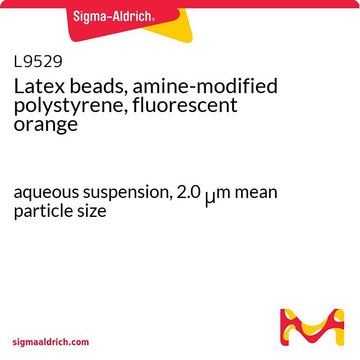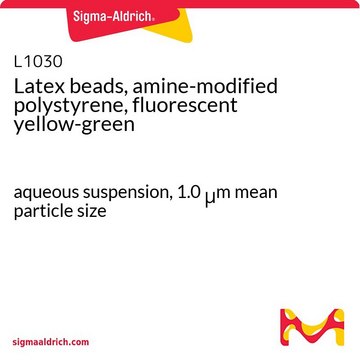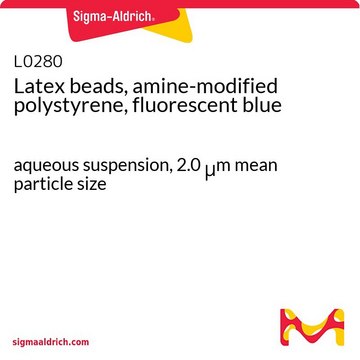L1148
Latex beads, deep blue dyed
0.055 μm mean particle size, aqueous suspension, solids 10 %
Autenticatiper visualizzare i prezzi riservati alla tua organizzazione & contrattuali
About This Item
Prodotti consigliati
Stato
aqueous suspension
Livello qualitativo
Composizione
solids, 10%
Dimens. media particelle
0.055 μm
Cerchi prodotti simili? Visita Guida al confronto tra prodotti
Applicazioni
Latex beads have been used to study the regulation of primary mesenchyme cell migration in the sea urchin embryo and to gain a better understanding of the role of ecto-NAD+ glycohydrolase, an enzyme predominantly associated with phagocytic cells. Latex beads have also been used to develop a new technique for measuring the plaque-forming cell (PFC) responses to bacterial antigens.
Caratteristiche e vantaggi
Dye incorporated into beads, not surface-linked
Codice della classe di stoccaggio
12 - Non Combustible Liquids
Classe di pericolosità dell'acqua (WGK)
WGK 3
Punto d’infiammabilità (°F)
Not applicable
Punto d’infiammabilità (°C)
Not applicable
Scegli una delle versioni più recenti:
Possiedi già questo prodotto?
I documenti relativi ai prodotti acquistati recentemente sono disponibili nell’Archivio dei documenti.
I clienti hanno visto anche
Gary G Martin et al.
The Biological bulletin, 211(3), 275-285 (2006-12-21)
Peritrophic membranes (PTMs) are secreted acellular layers that separate ingested materials from the gut epithelium in a variety of invertebrates. In insects and crustaceans, PTMs are produced in the midgut trunk (MGT, or intestine), but the MGT in decapod crustaceans
C A Ettensohn et al.
Developmental biology, 117(2), 380-391 (1986-10-01)
After their ingression, the primary mesenchyme cells (PMCs) of the sea urchin embryo migrate within the blastocoel, where they eventually become arranged in a characteristic ring-like pattern. To gain information about how the movements of the PMCs are regulated, a
C D Muller et al.
Biology of the cell, 68(1), 57-64 (1990-01-01)
In order to gain a better understanding of the role of ecto-NAD+ glycohydrolase, an enzyme predominantly associated with phagocytic cells, we have studied its fate in murine macrophages (splenic, resident peritoneal and Kupffer cells) during phagocytosis of opsonized on mannosylated
O Bagasra et al.
Journal of immunological methods, 49(3), 283-292 (1982-03-26)
A new latex bead technique for measuring the plaque-forming cell (PFC) responses to bacterial antigens is described. This technique has been designed for the study of antigens that cannot be readily coated onto SRBC but may also used for antigens
Il team dei nostri ricercatori vanta grande esperienza in tutte le aree della ricerca quali Life Science, scienza dei materiali, sintesi chimica, cromatografia, discipline analitiche, ecc..
Contatta l'Assistenza Tecnica.









